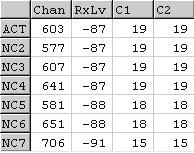 Screen Image 1
Screen Image 1Readers and cell site analysis students will recall the thread at http://trewmte.blogspot.com/2007/01/gsm-radio-test-measurements.html regarding GSM Radio Test Measurements. In that thread the discussion related to possible anomalies and interpretation regarding radio test measurements. In this thread I want to highlight another radio anomaly termed non-dominance that may occur.
Generally speaking, non-dominance occurs when radio coverage from two or more radio sources are equally aligned so that they all become dominant. The rare event in Screen Image 1 displays coverage quality and signal strengths of four radio sources are all equal to each other, in a confined area, where the receiver is in the idle mode and at ground level. Attempting to define that one particular Mast would be used to make or receive a mobile call in these circumstances might be difficult. The problems interpreting outcomes due to non-dominance could be numerous. For instance:
i) Who is to say that the receiver camped on a Mast's coverage shown by ACT would actually use that Mast? The coverage at NC2, NC3 and NC4 are equally as likely to be candidates to carry a mobile call.
ii) What happens in the case that the Mast's coverage upon which the receiver is camped at ACT the Mast is not actually best placed or line of sight with the receiver and in other circumstance would not be considered at first instance to serve the geographical area? The receiver under these conditions could be placed in an entirely different geographical area simply from summarising the Mast details shown in the mobile call records.
iii) When call setup (OACSU) takes place and a connection made it could be possible a mobile ‘phone starts a connection for less than a second on the Mast at ACT but forced into hard handover immediately thereafter thus shifts the call to another Mast (say, NC4)? It could be possible the Mast at ACT is shown as the Mast in the call records, which could be rather misleading when attempting to consider geographical location of the mobile telephone when compared to a particular mobile call.
iv) How can the radio examiner, from looking at historical records, correspond radio test measurements against the outward set of event elements recorded in call records? Non-dominance may mean a series of calls being made at one location handled by numerous Masts – thus may amount to a suggestion from analysis of the Masts usage from the call records that the mobile is on the move when in fact it is rather confined to an area. Non-dominance may result in a high number of short duration mobile calls shown in the call records. The short duration calls may not be due to the user terminating the calls, but rather the network dropping the calls.
I introduced, I believe, GSM non-dominance as an important radio anomaly to be considered regarding evidence of radio test measurements into the first criminal case in the UK back in 2003 at the Central Criminal Court (Old Bailey). GSM non-dominance was identified and shown in my evidence. Three other experts appearing for the prosecution or other defendants received my report. Acceptance of my results and findings were agreed and no challenges were made. However, I should point out that the discovery that non-dominance can occur for radio coverage was not my invention but arose from radio propagation studies by mobile network radio engineers endeavouring to agree anomalies for radio principles. The non-dominance principle had already been adopted for the Tetra standards and is accepted in GSM radio parlances as a noteworthy event. Therefore, I was fairly well armed with other independent findings.
The purpose of this discussion thread is to provide yet another example of radio conditions that can prevail when conducting GSM radio test measurements. That simply analysing call records may only present half a picture – a trompe l’oiel ( a lie to the eye) if you will.
No comments:
Post a Comment